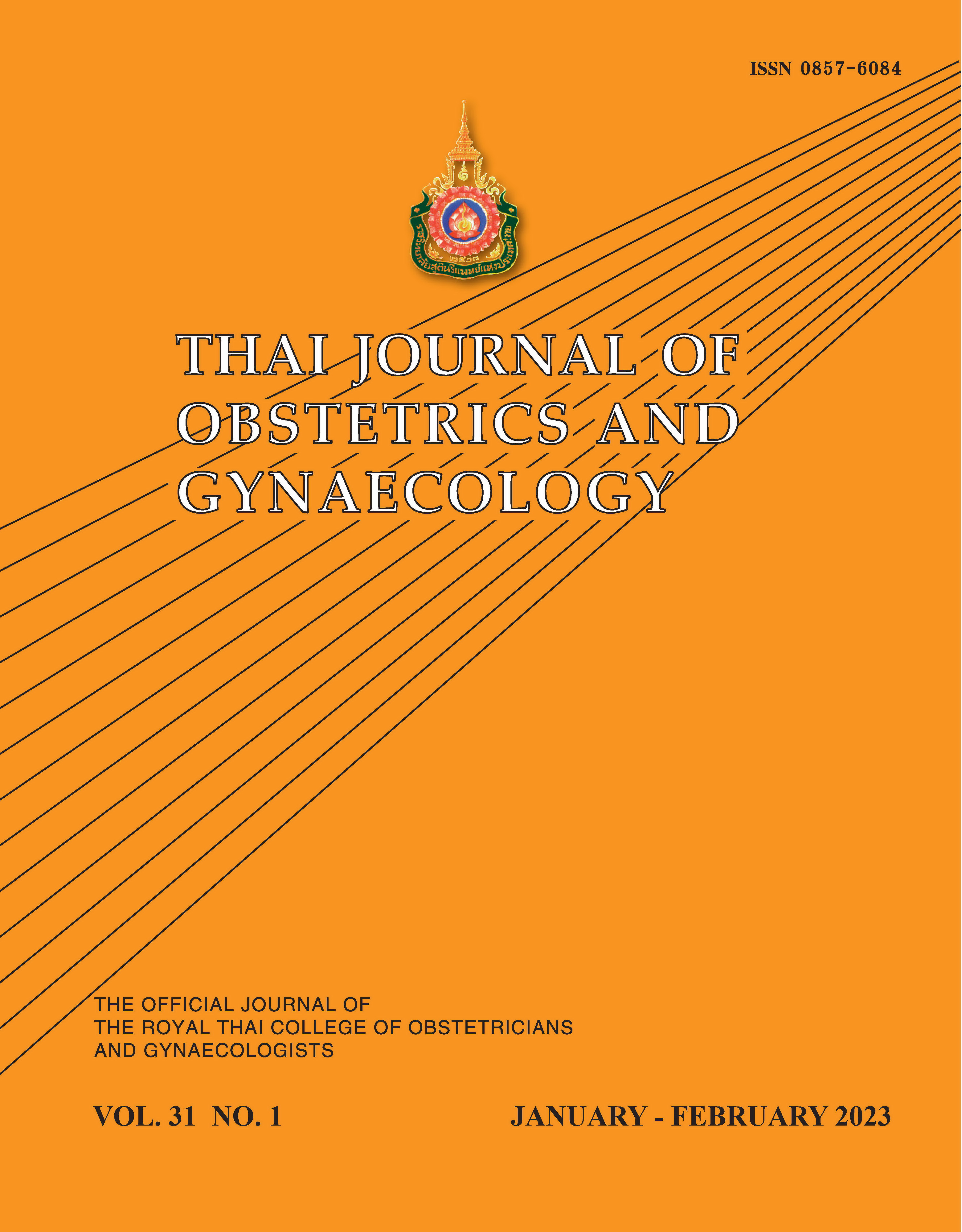Pregnancy Outcomes in Term Pregnancy with Isolated Oligohydramnios
Main Article Content
Abstract
Objectives: To compare birth asphyxia between term pregnant women with isolated oligohydramnios and normal amniotic fluid (AFI).
Materials and Methods: A retrospective cohort study was conducted in pregnant women who delivered in Charoenkrung Pracharak Hospital from January 1st, 2018, to December 31st, 2020. Obstetrics data and neonatal outcomes were noted among 756 women. Pregnancy outcomes in term pregnancy with isolated oligohydramnios of all 252 pregnant women (study group) were compared to those 504 pregnant women and low-risk pregnancy with normal amniotic fluid index (control group) in 1:2 ratio.
Results: The mean of gestational age of all participants was 38.63 ± 1.03 weeks. The mean AFI were 3.72 ± 1.21 cm and 10.73 ± 2.96 cm in the study and control groups, respectively. Isolated oligohydramnios (study group) was associated with a higher rate in nulliparous (46.4% vs 37.4%, p = 0.014) than in the control group. Moreover, pregnant women with isolated oligohydramnios had a significantly higher incidence of birth asphyxia (4% vs 1.4%, p = 0.024), neonatal intensive care unit admission (5.6% vs 0.4%, p < 0.001), and sick newborn admission (21% vs 13.1%, p = 0.005). There was a higher incidence of primary cesarean section in the study group when compared to the control group (30.6% vs 12.3%, p < 0.001). The justification of the higher rate of cesarean section in the study group was non-reassuring fetal heart rate status (14.7% vs 2.6%, p = 0.001) and failed medical induction (8% vs 1.2%, p = 0.001) when compared to the control group.
Conclusion: Isolated oligohydramnios in term pregnancy significantly increased the risk of birth asphyxia at 1 min and incidence of cesarean section.
Article Details

This work is licensed under a Creative Commons Attribution-NonCommercial-NoDerivatives 4.0 International License.
References
Sathyapriya K, Sonal A, Venkateswaramurthy N, Sambathkumar R. Research on prevalence of oligohydramnios in third trimester of pregnancy and its outcome. Int J Life Sci Pharma Res 2019;9:7-13
Cunningham FG, Leveno KJ, Bloom SL, Dashe JS, Hoffman BL, Casey BM, et al. Williams Obstetrics. 25th ed. New York: McGraw-Hill 2018:225-32.
Bansal D, Deodhar P. A clinical study of maternal and perinatal outcome in oligohydramnios. J Res Med Den Sci 2015;3:312-6.
Naveiro-Fuentes M, Prieto AP, Ruíz R S, Badillo M PC, Ventoso F M, Vallejo JLG. Perinatal outcomes with isolated oligohydramnios at term pregnancy. J Perinat Med 2016;44:793-8.
Ahmar R, Parween S, Kumari S, Kumar M. Neonatal and maternal outcome in oligohydramnios. Int J Contemp Pediatr 2018;5:1409-13.
Shrem G, Nagawkar SS, Hallak M, Walfisch A. Isolated oligohydramnios at term as an indication for labor induction. Fetal Diagn Ther 2016;40:161-73.
American College of Obstetricians and Gynecologists. Practice Bulletin, No.227. Fetal growth restriction: Obstet Gynecol 2021;137:e16-e28.
Hou L, Wang X, Hellerstein S, Zou L, Ruan Y, Zhang W. Delivery mode and perinatal outcomes after diagnosis of oligohydramnios at term in China. J Matern Fetal Neonatal Med 2020;33:2408-14.
Tahmina S, Prakash S, Daniel M. Maternal and perinatal outcomes of induction of labor in oligohydramnios at term-a retrospective cohort study. J Matern Fetal Neonatal Med 2020;33:2190-4.
Shanks A, Tuuli M, Schaecher C, Odibo AO, Rampersad R. Assessing the optimal definition of oligohydramnios associated with adverse neonatal outcomes. J Ultrasound Med 2011;30:303-7.
Patel PK, Pitre DS, Gupta H. Pregnancy outcome in isolated oligohydramnios at term. Nat J Commun Med 2015;6: 217-21.
Rabie N, Magann E, Steelman S, Ounpraseuth S. Oligohydramnios in complicated and uncomplicated pregnancy. Ultrasound Obstet Gynecol 2017;49:442-9.
Biradar K, Shamanewadi A. Maternal and perinatal outcome in oligohydramnios. Int J Reprod Contracept Obstet Gynecol 2016;5:2291-4.
Woday A, Muluneh A, St Denis C. Birth asphyxia and its associated factors among newborns in public hospital. PLoS One 2019;14:e0226891.
Aslam HM, Saleem S, Afzal R, Iqbal U, Saleem SM, Shaikh MW, Shahid N. Risk factors of birth asphyxia. Ital J Pediatr 2014;40:1-9.
Mulugeta T, Sebsibe G, Fenta FA, Sibhat M. Risk factors of perinatal asphyxia among newborns delivered at public hospitals in Addis Ababa. Pediatric Health Med Ther 2020;11:297-306.
American College of Obstetricians and Gynecologists. Committee opinion no. 644: The apgar score. Obstet Gynecol 2015;126:e52-e55.
Figueroa L, McClure EM, Swanson J, Nathan R, Garces AL, Moore JL, et al. Oligohydramnios: a prospective study of fetal, neonatal and maternal outcomes in low-middle income countries. Reprod Health 2020;17:1-7.
World Health Organization. Perinatal asphyxia. NBHU 2021; (https://www.who.int/teams/maternal-newborn-child-adolescent-health-and-ageing/newborn-health/perinatal-asphyxia)
Asnafi N, Bouzari Z, Mohammadnetadj M. Oligohydramnios and pregnancy outcome: Ten-years review. Int Biol Biomed J 2015;1:23-8.
Ashwal E, Hiersch L, Melamed N, Aviram A, Wiznitzer A, Yogev Y. The association between isolated oligohydramnios at term and pregnancy outcome. Arch Gynecol Obstet 2014;290:875-81.
Nankali A, Hematti M, Talebi A. Fetomaternal outcomes in cases of term oligohydramnios of 2017;3:37-42.
American College of Obstetricians and Gynecologists Committee Opinion No. 764: Medically indicated late-preterm and early-term deliveries. Obstet Gynecol 2019;133:e151-e155.
Casey BM, McIntire DD, Bloom SL, Lucas MJ, Santos R, Twickler DM, et al. Pregnancy outcomes after antepartum diagnosis of oligohydramnios at or beyond 34 weeks gestation. Am J Obstet Gynecol 2000;182: 909-12.
Blitz MJ, Rochelson B, Stork LB, Augustine S, Greenberg M, Sison CP, et al. Maternal body mass index and amniotic fluid index in late gestation. J Ultrasound Med 2018;37:561-8.


